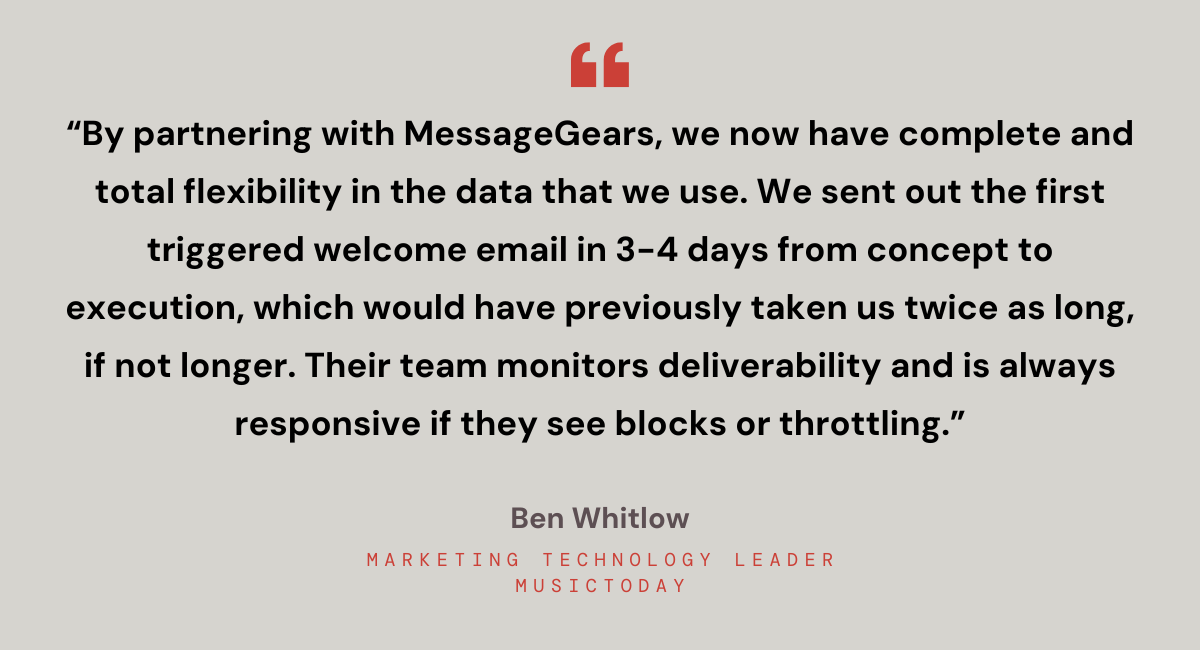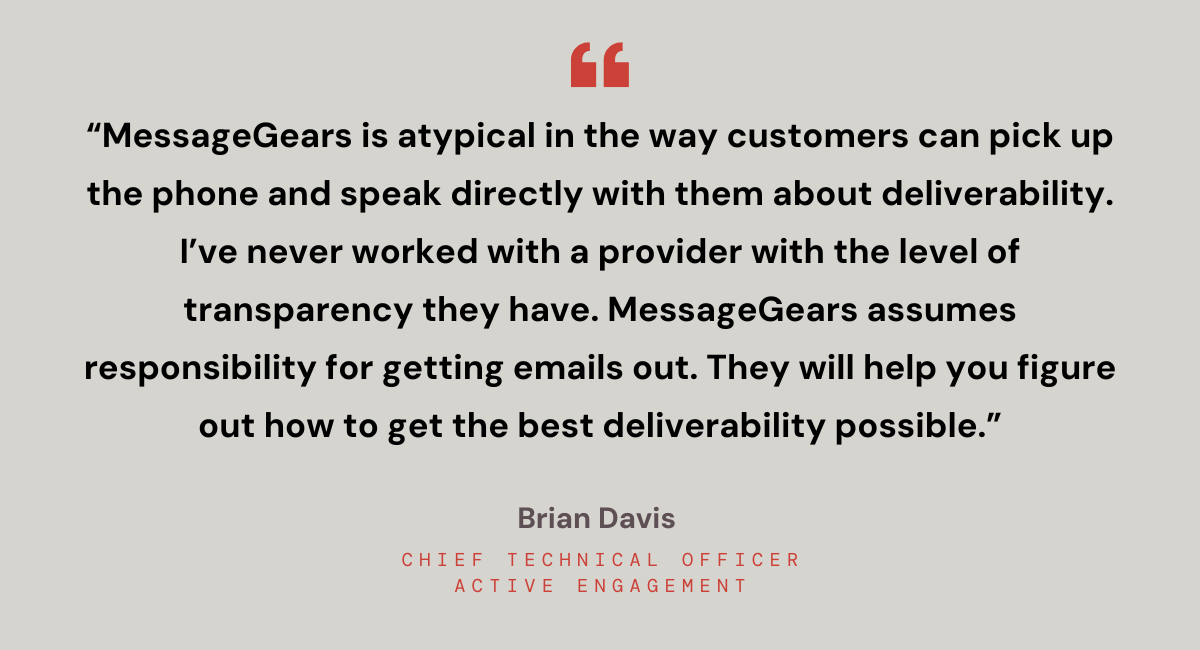Blog
5 best practices for email deliverability
Published on October 6, 2025

Brad Gurley

It’s old news that email marketing is one of the top drivers of customer engagement, yielding the highest potential ROI of all marketing channels. Marketing departments are often building entire budgets around email – but are they optimizing those email efforts to improve deliverability?
Global deliverability rates average around 85%, but most brands aim for 95%+. While trends in deliverability and engagement are trending upward as a whole, the industry average doesn’t mean much if your organization’s mail isn’t making the cut.
Nearly all major mailbox providers use machine learning to determine how they should filter inbound mail. Their primary goal is to ensure their users are happy by delivering “wanted” mail to the inbox and keeping everything else out – whether that means it’s never delivered or gets filtered to spam. These filters monitor user engagement and sender reputation in real time to determine how mail is routed on their networks.
As a sender, you’ll need to follow some core best practices if you want to be sure your emails reach the inbox.
1. Organic list building with clear consent
Organic list growth, along with acquiring clear opt-in, is the cornerstone of good email deliverability. Building a contact list through purchase, email appends, or any other third-party source will damage your sending reputation and hurt your chances of reaching the inbox.
It’s not a new concept, but it’s crucial to understand that higher volume doesn’t necessarily mean higher ROI. Sending to purchased or otherwise non-permission lists will drive high hard bounces, complaints, and trap hits – all facets that can seriously hurt your deliverability. Building your email database the right way will help keep engagement high and emails in front of the consumers that matter. If you’re not following best practices in acquiring your subscriber database, you’re not likely to see optimal inbox placement… even if you’re following the other suggestions included here.
2. Good data hygiene across your lists
Even a permission-based list of recipients isn’t guaranteed to be free of deliverability issues. Over the life of a subscription, an email address may change or be abandoned, or the subscriber may lose interest or unsubscribe. This is why it’s so important to manage and clean your data – and I’m not just talking about using an email validation tool for new contacts. It’s crucial to establish internal processes for consistently removing hard bounces, complaints, and unsubscribes in a timely fashion.
You may be especially susceptible to list hygiene issues if you offer a one-time promotion, contest, or discount on a product. Consumers may even sign-up fake or mistyped addresses, which commonly end up being invalid (hard bounce) or, even worse, a spam trap. Recipients who signed up more than a year ago may no longer have an interest in or even remember signing up for your emails. Attempting to proactively re-engage your email recipients and eventually removing unengaged addresses on a regular basis is a great way to maintain strong deliverability.
3. Consistent sending patterns
A consistent sending frequency and cadence is key. This allows recipients to have expectations for your brand’s emails. Mailbox providers rely heavily on patterns and consistency when assigning a sending reputation. Sending emails on a repeated pattern (same days each week, roughly the same volume for each type of mailing) can help the providers identify and assign a reputation for your mailstream. Sending a triggered welcome message upon sign-up is a great way to remind users why they subscribed and to set the expectation for tone and frequency. Once you’ve set those expectations, recipients are more likely to also remember when to look for your messages and what type of content and branding they’ll see within.
Setting up a preference center, allowing users to control the amount and type of emails they want to receive from a brand, can be helpful in driving engagement and limiting complaints/unsubscribes. Once you’ve set the expectation (either by welcome message, preference center, or otherwise), stick with it. Reach out to your subscribers if you’ll be experiencing any notable change in sending frequency, branding, or content. Be sure to start slow and work your way up when sending from a new domain or IP, too.
4. Strategic segmentation and personalization
Targeting your most engaged users most frequently is a great way to start generating better inbox placement and engagement metrics. Optimizing the times email campaigns are sent is another great way to ensure messages aren’t missed and engagement remains high.
Enterprise senders can take this even further by leveraging more first-party data and real-time triggers to personalize at scale – a key differentiator in today’s filtering environment. Using subscriber information like location, purchase history, and browser behavior will help better target your subscriber base. Real-time data that populates dynamically will help ensure every message is relevant to the recipient.
And not to be repetitive, but a targeted re-engagement strategy with solid win-back campaigns can also do wonders to help keep your subscriber list solid. The better you’re able to identify what your subscribers want and how to provide it to them, the more likely you are to reach and resonate with them.

5. Optimize for mobile
The rate at which consumers are reading emails on mobile devices continues to rise. More than 40% of email opens typically take place on a mobile device. Extensive testing to ensure mobile optimization (not just compatibility!) should be a no-brainer for enterprise email teams at this point. A poor user experience could mean no response, no action or, in other words, no ROI.
Another important element of mobile engagement is the unsubscribe method. Both Gmail and Apple have implemented steps in recent years that make it easier for recipients to unsubscribe on their mobile apps with links that appear at the very top of email messages. While data has shown that recipients aren’t likely to unsubscribe just because these links exist, they will if your message isn’t relevant to them.
Email deliverability is a long game
This is by no means a comprehensive list of best practices. Email deliverability will only continue to become more complex as AI algorithms and machine learning become even more prevalent and advanced. But following these basic best practices will help your team build a foundation for good deliverability now and years to come.

Related resources:

Brad Gurley Director of Deliverability
Serving as MessageGears’ Director of Deliverability, Brad spends his days watching mail queues, analyzing customer delivery data, and researching the latest updates to email technology. He’s been in the email marketing space for the better part of two decades and harbors a passion for educating senders on how to more effectively deliver mail to their subscribers. When he’s not busy updating MTA configurations, you might find him preparing a variety of smoked meats or leading a group of friends to the closest karaoke bar.